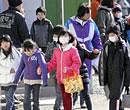
Further cabling inside was underway before an attempt to restart water pumps needed to cool overheated nuclear fuel rods at the six-reactor Fukushima plant in northeastern Japan, 240 km (150 miles) north of Tokyo.
Japan's unprecedented multiple crisis of earthquake, tsunami and radiation leak has unsettled world financial markets, prompted international reassessment of nuclear safety and given the Asian nation its sternest test since World War Two.
It has also stirred unhappy memories of Japan's past nuclear nightmare -- the U.S. atomic bombs dropped on Hiroshima and Nagasaki in 1945.
Working inside a 20 km (12 miles) evacuation zone at Fukushima, nearly 300 engineers were focused on trying to restore power at pumps in four of the reactors.
"TEPCO has connected the external transmission line with the receiving point of the plant and confirmed that electricity can be supplied," the plant's operator Tokyo Electric Power Co said in a statement.
Another 1,480 meters (5,000 feet) of cable are being laid inside the complex before engineers try to crank up the coolers at reactor No. 2, followed by 1, 3 and 4 this weekend, company officials added.
Should that work, it will be a turning point.
"If they can get those electric pumps on and they can start pushing that water successfully up the core, quite slowly so you don't cause any brittle failure, they should be able to get it under control in the next couple of days," said Laurence Williams, of Britain's University of Central Lancashire.
If not, there is an option of last resort under consideration to bury the sprawling 40-year-old plant in sand and concrete to prevent a catastrophic radiation release.
That method was used to seal huge leakages from the 1986 Chernobyl disaster.
Underlining authorities' desperation, fire engines sprayed water overnight in a crude tactic to cool reactor No. 3, considered the most critical because of its use of mixed oxides, or mox, containing both uranium and highly toxic plutonium.
Japan has raised the severity rating of the nuclear crisis from level 4 to level 5 on the seven-level INES international scale, putting it on a par with the Three Mile Island accident in 1979, although some experts say it is more serious.
Chernobyl, in Ukraine, was a 7 on that scale.
THOUSANDS DEAD, MISSING AND SUFFERING
The operation to avert large-scale radiation has overshadowed the humanitarian aftermath of the 9.0-magnitude quake and 10-meter (33-foot) tsunami that struck on March 11.
Nearly 7,000 people have been confirmed killed in the double natural disaster, which turned whole towns into waterlogged and debris-shrouded wastelands.
Another 10,700 people are missing with many feared dead.
Some 390,000 people, including many among Japan's aging population, are homeless and battling near-freezing temperatures in shelters in northeastern coastal areas.
Food, water, medicine and heating fuel are in short supply.
"Everything is gone, including money," said Tsukasa Sato, a 74-year-old barber with a heart condition, as he warmed his hands in front of a stove at a shelter for the homeless.
Health officials and the U.N. atomic watchdog have said radiation levels in the capital Tokyo were not harmful. But the city has seen an exodus of tourists, expatriates and many Japanese, who fear a blast of radioactive material.
"I'm leaving because my parents are terrified. I personally think this will turn out to be the biggest paper tiger the world has ever seen," said Luke Ridley, 23, from London as he sat at Narita international airport using his laptop.
"I'll probably come back in about a month."
Amid their distress, Japanese were proud of the 279 nuclear plant workers toiling in the wreckage, wearing masks, goggles and protective suits sealed by duct tape.
"My eyes well with tears at the thought of the work they are doing," Kazuya Aoki, a safety official at Japan's Nuclear and Industrial Safety Agency, told Reuters.
G7 INTERVENTION FOR YEN
The Group of Seven rich nations succeeded in calming global financial markets in rare concerted intervention to restrain a soaring yen.
The U.S. dollar surged to 81.98 yen on Friday after the G7 moved to pour billions into markets buying dollars, euros and pounds -- the first such joint intervention since the group came to the aid of the newly launched euro in 2000.
The yen later dropped back to under 81, but it was still far from the record low of 76.25 hit on Thursday.
"The only type of intervention that actually works is coordinated intervention and it shows the solidarity of all central banks in terms of the severity of the situation in Japan," said Kathy Lien, director of currency research at GFT in New York.
Japan's Nikkei share index ended up 2.7 percent, recouping some of the week's stinging losses. It has lost 10.2 percent this week, wiping $350 billion off market capitalization.
The plight of the homeless worsened following a cold snap that brought heavy snow to worst-affected areas.
Nearly 290,000 households in the north were still without electricity, officials said, and the government said about 940,000 households lacked running water.
Aid groups say most victims are getting help, but there are pockets of acute suffering.
"We've seen children suffering with the cold, and lacking really basic items like food and clean water," Stephen McDonald of Save the Children said in a statement on Friday.